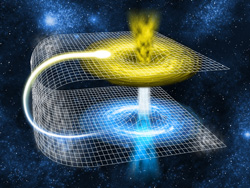Dynamics of quantum gravity theories examined
After furthering their knowledge of quantum gravity (QG) theories such as loop QG, spin foam models and causal dynamical triangulations, scientists want to investigate the dynamics of these theories by developing computational and perturbative techniques. This research is aimed, in particular, at analysing the implications of their properties for cosmology. The 'Physical observables in quantum gravity' (Observables in QG) project team notes that all these theories use some kind of discreteness either as an auxiliary structure or as a derived property. They add that this opens the question of how this discreteness interacts with the symmetry at the heart of general relativity, namely the so-called diffeomorphism symmetry. During the seven month of this project, researchers undertook the first steps to discuss representations of the diffeomorphism group in discretised theories of QG. After providing a clear definition of diffeomorphisms in discretised theories, they succeeded in showing that in general diffeomorphism symmetry is broken on the discretised level. The scientist then examined possible approaches to obtain consistent dynamics for quantum theories of gravity.



